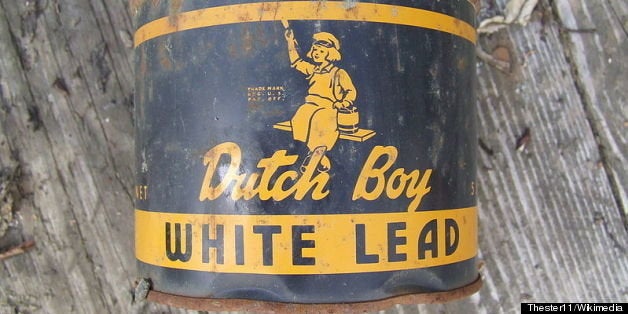
A lawsuit in California that seeks some $1 billion from former lead paint manufacturers is far from the first attempt to hold the industry liable for decades of poisoning children and leaving lingering contamination.
But experts such as Richard Rabin -- who directed a lead poisoning registry at the Massachusetts Department of Labor for over 20 years -- think the case just might be the first to finally succeed, marking the end of a long losing streak.
"My ideal hope is something along the lines of what happened with tobacco," said Rabin, who initiated the inaugural trial against the lead paint industry more than 25 years ago.
"It's gone on and on and on," he said of lead litigation, even as research uncovering lead's dangers, "keeps coming and coming."
After fending off lawsuits since the 1950s, the tables eventually turned on big tobacco, forcing the industry to pay out hundreds of billions of dollars in the late 1990s. At that point, it had become common knowledge that the industry was well aware of the addictive qualities and the health hazards of their products.
In 1987, with nearly a century of documented dangers accumulated on childhood lead poisoning, a lawsuit -- spurred by Rabin -- was filed on behalf of a Boston girl exposed to lead paint as a toddler.
"I want to be a lawyer, but I don't think I can do the studying,'' Monica Santiago told The New York Times in 1988, then 15 years old. ''In school they teach me, but I forget. The kids call me dumb. Sometimes when I do homework I cry and rip it up. Sometimes I get mad or sad and don't know why. My tears fall fast.''
Rabin said the paint companies prevailed based largely on technicalities and not merit, as they have in a series of similar cases since.
In the most recent trial, completing its third week Friday, 10 California cities and counties brought suit against representatives of five lead paint companies. The representatives say the favorable court decisions up to this point were the right ones, because the companies have never been in the wrong.
The paint industry has funded no-strings-attached research on the effects of lead and adopted voluntary standards years before federal regulations were put in place.
"We don't deny documents show the companies were aware of the risks to workers in their plants in 1900, due to incredibly high exposures to lead," said Tim Hardy, an attorney for NL Industries Inc. (formerly the National Lead Co.), makers of Dutch Boy paints and defendants in the trial. "That's a very different thing from knowing how much lead is coming from where and might be a problem to children today."
Industry representatives also brushed off common criticisms that the Dutch Boy mascot, who debuted in 1907 in National Lead Co's advertisements, kids' paint books and other materials, was targeted at children.
"There are lots of ads going back to the early 20th century using children in various poses -- Campbell's soup, all sorts of products," Hardy said. "That was just a mode of advertising."
"It's rather absurd to think that companies would market to children -- children don't make paint purchasing decisions," added Bonnie J. Campbell, a representative of the defendants. "The books were so that kids could have something to do while parents pick out paint colors."
Of note, a Dutch Boy ad in 1918 recommended that paint merchants "cater to the children," and remember that "the children of today are the grown-ups of tomorrow."
David Rosner and Gerald Markowitz, authors of the new book Lead Wars, compare the marketing strategy to that of tobacco's kid-friendly cartoon icon, Joe Camel. They also note that the lead paint and tobacco industries hired the same public relations firm -- Hill and Knowlton, in 1943 and 1953, respectively -- to help instill doubt about health hazards, garner positive media attention and keep litigation at bay.
"It was clear that for decades the lead industry had looked on childhood lead poisoning as a public relations problem, not a public health crisis," Rosner and Markowitz wrote.
Critics of the lead paint industry suggest the companies enlist similar strategies today.
Perry Gottesfeld, a member of the U.S. Centers for Disease Control and Prevention's Advisory Committee on Childhood Lead Poisoning Prevention, testified in the California court. Gottesfeld recalled how a representative for Sherwin-Williams Co. -- another defendant in the case -- refused to disclose her industry connection during a January 2012 public hearing in which the representative objected to federal guidelines that would further protect children from lead poisoning.
Dale Leibach, another spokesperson for the defendants, told HuffPost that the attorney was upfront that she advised clients on issues related to lead exposure and effects.
The CDC advisory panel ended up recommending that the threshold level of concern for lead in a child's blood be cut in half, from 10 micrograms per deciliter of blood to 5. Yet the agency still warns that no level of lead exposure is safe.
"There is ongoing harm down to the lowest measurable levels," Bruce Lanphear, a researcher at Simon Frasier University in British Columbia and expert witness for the plaintiffs, said during the first week of the trial in California. He referenced the heavy metal's effects on puberty, behavior and intellect, including his research that found an increase in lead in the blood from less than one to 10 microgram deciliter was associated with a roughly six-point drop in IQ.
In an interview with HuffPost earlier this year, Lanphear described another study in which he found exposure to both lead and tobacco can magnify their individual effects on the risk of attention-deficit hyperactivity disorder.
Still, the defendants argue that the proposed remedy of stripping the toxic heavy metal remaining on millions of residences throughout California goes too far. If simply kept intact, they note, lead paint poses no risks.
Paul Mushak, a toxicologist with expertise in lead paint, testified during week one of the trial that even homes with "intact surfaces" have hazardous levels of toxic dust due to the friction from opening and closing windows and doors.
Dr. Cyrus Rangan, director of toxics epidemiology in Los Angeles County, another witness for the plaintiffs, added that he's seen poisoning cases where the child was exposed to hazardous dust from windows despite no other visible deterioration in the home.
Disagreement also abounds as to when dangers of lead dust were known by the lead paint industry. Most attention in the early 20th century was directed at sweet-tasting lead paint chips, the source of exposure for Monica Santiago, the plaintiff in the '80s lawsuit. Dust's dangers, industry representatives told HuffPost, were not known until more recently.
In Lead Wars, however, Rosner and Markowitz highlight a 1913 report from Dr. Alice Hamilton, a well-respected physician, which stated that "the danger from the use of lead paints comes from paint dust in the air and from paint smeared on the hands which may be carried into the mouth with food or tobacco."
And critics suggest that lead paint makers and tobacco companies have used similar tactics when faced with growing evidence that their respective products' are harmful to health.
As public anxiety over the health risks of smoking began to rise in the 1940s and 1950s, for example, tobacco ad campaigns began featuring physicians to assure consumers of the safety of cigarettes.
"More doctors smoke Camels than any other cigarette," read a 1946 ad from the R.J. Reynolds Tobacco Company. The M and D of the first two words were highlighted in red.
A Dutch Boy paint advertisement from 1927 shows a baby smudging a wall, under the title "Finger Prints." Not only is a lead-painted wall easy to clean, suggested the ad, but it's also safe for young children -- despite the fact that a baby's hands often end up in their mouth.
Then there was the grinning Dutch Boy himself, which Rabin recalled as "ubiquitous" when he was a young boy.
The logo, modeled after a 9-year-old Irish boy, carried a paint can in one hand and a brush lathered with leaded liquid in the other.
"I didn't put it all together and realize what they were doing until years later," Rabin said. "Then I was just outraged."

